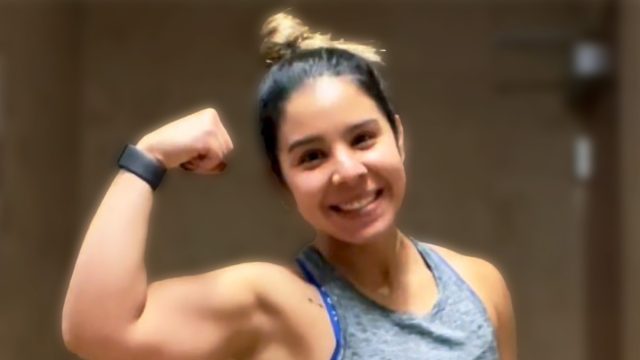Woman Loses 28 Pounds in 4 Months After Stopping These 7 Mistakes
Are you holding on to bad habits that are preventing you from losing weight? Luisana Carrero is a nutrition coach and social media influencer who knows how to lose weight and keep it off from personal experience. In fact, she ended up losing 28 pounds in 4 months once she realized the behaviors that kept her from achieving her goals. In a new post, she revealed seven habits she wished she knew about sooner.
You Are Eating Healthy But Consuming Too Many Calories
"Eating healthy doesn't necessarily equal weight loss. For a long time, I was eating healthy without paying attention to the amount of calories I was consuming. But, if you're not eating the right amount for your body, you won't see the results you are looking for," she says in her post.
RELATED: Weight Loss Coach Reveals 6 Daily Habits That Help Clients Drop 2 Pounds Every Week
You Are Cutting Carbs But Not Eating Complex Carbs
A zero-carb diet isn't necessarily the best way to lose weight. "You don't need to cut out carbs to lose weight. Instead, opt for complex carbs that are high in fiber, vitamins/minerals, and measure your portions to ensure you're staying in a calorie deficit," she says.
You Avoid Eating After 8
You don't have to be super strict when it comes to meal timing, according to Luisana. "You can eat after 8 PM and still lose weight. The time you eat doesn't matter; it's the total calories that count. However, eating too close to bedtime might disrupt your sleep," she says.
You Weigh Yourself Just Once a Week
You don't have to fear the scale, she continues. "Instead of weighing yourself once a week, try weighing yourself 3-4 times a week and averaging the results. This gives a more realistic picture and helps track your progress better," she says.
RELATED: She Walked 10,000 Steps Every Day for a Month, and Here Is What Happened
You Aren't Eating the Right Food
"The key during a calorie deficit isn't to eat as little as possible BUT to eat MORE of the right foods. Focus on lean proteins, complex carbs, fiber, and fats. Opt for meals that are filling but lower in calories to help you stay satisfied longer," Luisana explains.
You Are Staying in a Deficit for Too Long
Don't restrict yourself for long periods of time, she warns. "Staying in a deficit for a long period of time can slow down your metabolism and make it HARDER to maintain your weight in the long run," she says. "Choose 10-14 weeks to be in a calorie deficit, be committed and consistent, and then take a break. Taking breaks allows your body to recover and prevents metabolic adaptations. It also makes your journey way more enjoyable."
You Aren't Walking
Also, don't forget to get your steps in. "Walking is the most underrated fat loss tool. Walking is one of the best things you can do to lose body fat because it's a low-impact, accessible form of exercise that helps increase your daily calorie burn without adding stress to your body. Adding a 30-minute daily walk made a big difference for me," she says.
Other Bad Habits? You Are Drinking Your Calories
In another post, she revealed some other habits that prevented her from losing weight. She also stopped drinking her calories. "I cut back on drinking from 4-5 drinks every weekend to only on special occasions," she reveals.
RELATED: 9 High-Protein Foods That Beat Eggs for Weight Loss
You Aren't Planning Your Workouts
She also stresses the importance of exercise planning. "I stopped going to the gym without a plan and started following a workout program, lifting weights at least 4x per week," she says.
Eat These High Protein Foods
As for high-protein foods, in another post, she unveils a list of her go-to's to get "140g of protein in a day and make fat loss easier."
- Non-Fat Plain Greek Yogurt: "I opt for plain Greek yogurt for lower calories and more protein. 200g Greek yogurt provides 22g of protein. I add stevia, peanut butte, and frozen blueberries to mine, I eat that for dessert every night," she explains.
- Chicken breast: "130g of cooked chicken breast will give you 40g of protein. I cook it in bulk and use it to make many different meals like grilled chicken sandwiches, tacos, salads, bowls," she said.
- 96/4 Lean Ground Beef: "140g of cooked ground beef provides 40g of protein. I cook it in bulk and make burger patties or use it for my pasta," she added.
- Egg whites: "200g of liquid egg whites will give you only 108 calories and 22g of protein. You can add liquid egg whites to your full eggs for more protein and more volume. I mix a cup of egg whites with 2 full eggs or use it for my French toast or my pancakes," she revealed.
- Fat-Free Cottage Cheese: "A serving of cottage cheese gives you 13g of protein. You can add it to your eggs, eat it with fruits, or add it to your salads," she concluded.
And if you enjoyed this article, take advantage of these 15 Quick Ways to Lose Body Fat Percentage in a Week.





